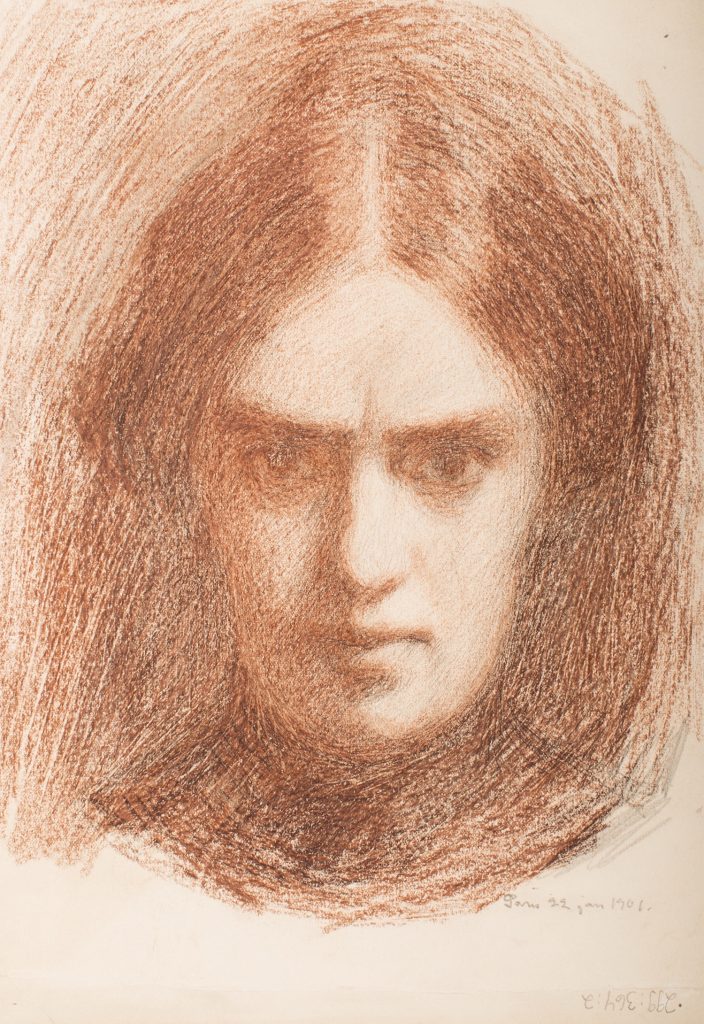I am Olli, an artistess
JANUARY 2019
In 1900, the artist Olga Gummerus (1876–1938) travelled to Paris, which was pulsating with the passions of the World Exposition. Because of the Exposition which had received a lot of attention, and especially because of its praised Finnish Pavilion, the city was teeming with Finns. The Finnish artistic community wished the newcomer welcome, even if there’s not a word about Miss Olga in the documents of the time; everybody simply called her Olli.
Olli wasn’t really a fledgling when she arrived in Paris: she had graduated, with several scholarships lifting her wings, from Ateneum, and in Paris she had already been once before. The first weeks passed rapidly by while she visited the World Exposition. However, gradually her everyday routine was stabilised while she started her art studies. Olli registered at the studio of Eugène Carrière, whom the symbolists adored. In addition, in the evenings she went to draw at the Académie Colarossi. Olli was open and curious to learn new things.
“I couldn’t imagine a better teacher”, Olli wrote to her mother. Eugène Carrière was good-natured and constructive in his critique, and his studio wasn’t as crowded as the other free academies. Through Carrière’s guidance, the outlines in Olli’s paintings became softer and the colours darker, approaching the misty and almost monochromatic painting style of the teacher.
In the studio there was an international atmosphere, in the group consisting of 15 students there were, apart from the two Finns, also American, Armenian, Italian, French and Moroccan students. Carrière emphasized the importance of observing nature. So took the students to the Museum of Natural History to look at animal skeletons. He also underlined that in a painting there should always be a deeper meaning – just copying nature isn’t enough.
After a couple of months of studying in Paris, Olli sat down by the mirror and scrutinised her face. Olli was a beautiful woman, she had numerous admirers and her fellow students vied with each other in painting portraits of her. Her black hair framed her face and in her black eyes there slumbered a mysteriousness.
Olli, however, wasn’t interested in her own beauty. She looked deeper and saw in herself a self-confident, assured, almost man-like woman. On the paper, a self-portrait was starting to take form, which doesn’t apologize nor avoid the viewer.
Self-Portrait
Olga’s self-portrait in Paris 1901 is amazing. Among the round traces of the pen, a woman, between whose eyes a stern wrinkle is forming, is staring intensely at us. “Here I am”, the painting seems to be saying, “I’m Olli, an artistess”. The role as a model reserved for women in the pages of art history doesn’t go with this painting, Olga isn’t seducing nor humble, she is not ashamed of existing. And she doesn’t accept to be just the object of our gaze. Olga answers to the gaze of every viewer with her own straight gaze.
Did Olga ever show the painting to her teacher Eugène Carrière? In the few exhibitions in which Olga participated, this work wasn’t shown. Did the self-portrait turn out so honest that Olga decided to keep it to herself?
Olga Gummerus hasn’t ended up in the pages of art history, because her production has hardly been shown at all: not during her lifetime nor after it. The Paris self-portrait makes you feel that it wasn’t because of a lack of self-confidence as an artist that she didn’t participate in exhibitions. Rather, studying her life makes you think that Olga didn’t have any need to give emphasis to herself or to her talent.
Olga continued her artistic career as the partner of her husband Eric O. W. Ehrström, and together they created a multifaceted career as designers.
Pälvi Myllylä
Director of Visavuori Museum


